Computerized mounts are often bundled with telescopes, particularly those for visual astronomy. Many of the mounts we have listed here are sold as package deals with telescope optical tubes and are priced slightly lower than purchasing them separately.
Most computerized mounts are either small and cheap alt-azimuth mounts or beefy equatorial mounts made for astrophotography. They almost always use a dovetail plate and saddle to quickly swap out whatever telescope is on top without the use of any tools. Most computerized mounts have a maximum weight capacity for what they can steadily hold; this stated limit is often a little too generous, and for astrophotography use, you shouldn’t load a mount with more than half of its stated weight limit if you want to achieve consistently good tracking/guiding.
Advantages & Disadvantages of Computerized Mounts
Computerized mounts will automatically find and track objects for you. However, many of them cannot be aimed manually at all, or at least without disrupting the GoTo system. Many cheaper computerized mounts are essentially useless when power is lost and cannot be adjusted at all manually. While some others may have clutches, unlocking them will cause the mount to have no idea where it is anymore and completely disrupt tracking and GoTo accuracy. Even if your mount does have clutches and encoders designed for a smooth transition between manual and computerized aiming, that won’t help if the telescope is bumped sufficiently hard.
Computerized mounts are also, ironically, a lot less time-efficient than manual mounts. Even the simplest computerized mount with simple smartphone-controlled setup and use will take a few minutes to level and align on a star. If nothing else, the limited speed at which the telescope moves around the sky will prevent a speedy startup process. Mounts with a hand controller usually require entering the time, date, and location every time you set them up and simply take longer to navigate. And a computerized equatorial mount requires all this plus accurate balancing and polar alignment, which can easily take 10+ minutes by itself. Even once set up, a computerized mount cannot move very quickly around the sky, and for easy-to-find objects, even a novice can get a manual mount aimed faster than a computerized mount can usually slew back and forth across the sky.
If you’re only planning on looking at easy-to-find objects anyway (such as with a small telescope), GoTo is going to be more of a hindrance than a help; it’ll also eat into the budget for funds that could go towards a better telescope or better accessories such as eyepieces.
Things to Look For
Any good computerized mount can take a 12V power source and uses a Vixen and/or Losmandy-style dovetail saddle. You should also look for mounts that have large diameter steel tripod legs and use stepper motors whenever possible, and the ability to use the mount with ASCOM drivers when plugged into a PC.
Best Computerized Mounts: Our Recommendations
Best in $400-$600: Sky-Watcher AZ-GTi
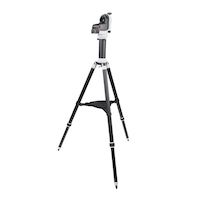
The Sky-Watcher AZ-GTi is a lightweight alt-azimuth mount controlled via your phone or tablet with SkySafari Pro or the SynScan app. The AZ-GTi can be aimed manually with or without being powered on and aiming it by hand will not affect alignment thanks to its FreedomFind encoder system. The mount can also be converted to a star tracker/equatorial mount with some add-ons to carry a large telephoto lens or small ED refractor for deep-sky imaging. For visual use, the AZ-GTi is able to hold up to a 6” Schmidt-Cassegrain, Newtonian, or Maksutov – or a 4” refractor. A Vixen-style dovetail saddle is used to attach your telescope tube to the AZ-GTi.
Sky-Watcher sells the GTi with 90mm, 102mm, and 127mm Maksutov-Cassegrain packages. The stripped-down AZ-GTe mount sold by Sky-Watcher with some telescopes is identical to the AZ-GTi but lacks the FreedomFind encoders, which is a major drawback.
$700-$850: Sky-Watcher Star Adventurer GTi
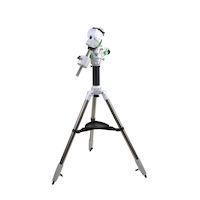
The Sky-Watcher Star Adventurer GTi is more or less an AZ-GTi with all of the equatorial mount conversion parts added in for you. You get the same tripod, app-controlled interface, FreedomFind encoders, Vixen-style saddle, and weight capacity.
However, there are some advantages such as a built-in illuminated polar scope, easier autoguiding capability, and a beefier latitude adjuster with a center of mass that’s more correctly placed above the center of the tripod compared to a janky AZ-GTi equatorial mount conversion. For visual use a 6” telescope is again about the limit of what you can comfortably use on this mount; a 70mm astrograph refractor or telephoto lens plus autoguiding equipment is the largest feasible astrophotography payload the Star Adventurer GTi can handle.
$850-$1050: Sky-Watcher EQM-35i
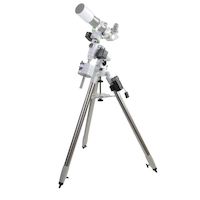
The Sky-Watcher EQM-35 mount used to have a hand controller, but the new EQM-35i update changes that. The EQM-35i uses a significantly heavier-duty tripod than the spindly affair bundled with the GTi mounts and has marginally more weight capacity – for visual use, a 6” telescope rides more comfortably and longer 4” refractors work, while an 80mm ED refractor is acceptable for astrophotography. However, the stated 22-lb weight capacity is a little too generous; 15 lbs is pushing it. The declination axis can be removed to add a Star Adventurer ball head or camera adapter, and there are two 7.5 lb counterweights supplied. There is no FreedomFind technology like the GTi mounts, however, so you need to be careful not to accidentally move the telescope manually on either axis with the EQM-35i.
$1050-$1300: Celestron Advanced VX
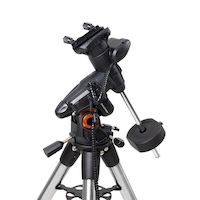
The Celestron Advanced VX dwarfs cheaper mounts, which are barely comparable in size or capacity, with gigantic 2” tubular steel tripod legs, a massive right ascension axis, a dual Vixen/Losmandy-style dovetail saddle and a 30 lb payload capacity. It can hold 10” or 11” SCT and Newtonian reflector telescopes (though we would recommend a bigger mount for those if possible) for visual use, or a 6” refractor. For astrophotography, a 6” Newtonian or 4” refractor rides comfortably. The Advanced VX does not come with a polar scope and is not as easy to interface with a PC as Sky-Watcher’s mounts, and the declination axis is the source of a lot of complaints due to issues with backlash and guiding accuracy for astrophotography. You also can’t aim the Advanced VX manually without disrupting its ability to slew accurately with GoTo. However, the Celestron All-Star Polar Align can help with polar alignment when the celestial pole is obstructed by trees or buildings, and the Advanced VX’s faults hardly matter for visual use. If you want a big dumb mount with a heavy payload capacity, you can’t go wrong with the Advanced VX.
$1300-$1900: Sky-Watcher HEQ5i
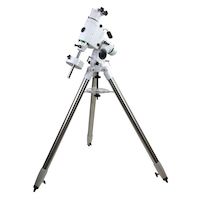
Like the other Sky-Watcher mounts, the Sky-Watcher HEQ5i now boasts control via your smartphone/tablet with apps by default due to a shortage of parts for hand controllers; you can still plug in a hand controller or a PC cable, however. The HEQ5i is similarly beefy to the Advanced VX but uses a tripod with narrower legs, limiting its visual payload to maybe 20 lbs – such as 8” SCTs, 6” Newtonians or 5” refractors. The HEQ5i’s saddle also only supports Vixen-style dovetail plates by default, though upgraded aftermarket saddles are available. However, the HEQ5i includes a polar scope, its counterweight shaft retracts inside the mount for storage/transport instead of having to be unscrewed, and it boasts various improvements in mechanical design that make it a much better choice for astrophotography.
$1900-$2400: Sky-Watcher EQ6Ri
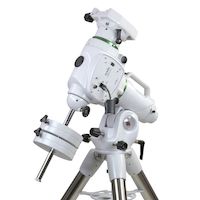
The Sky-Watcher EQ6Ri is similar to the Celestron CGEM in visual payload capacity and general design but features the same tracking improvements as the HEQ5i does over the Advanced VX. It has a dual saddle for both Vixen- and Losmandy-style dovetail plates, an integrated carry handle, built-in polar scope, and a retracting counterweight shaft like the HEQ5i, and is controlled via WiFi by default or with a plugged-in hand controller or PC cable. The EQ6Ri’s huge 44 lb payload capacity allows it to hold 12” telescopes for visual astronomy without a problem, and it’s ideal for deep-sky astrophotography use with 8” SCTs, Newtonians, or Ritchey-Chretien telescopes as well as big refractors.
$2400-$2800 – Sky-Watcher AZ-EQ6i
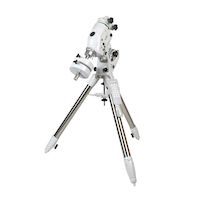
The Sky-Watcher AZ-EQ6i has the same basic features and the same capacity as the EQ6Ri but with a few bonuses. For starters, the AZ-EQ6i features Sky-Watcher’s FreedomFind technology to allow you to aim manually, which makes it great for use at outreach events when you’re worried about small bumps or if you’re in a hurry. You can use the AZ-EQ6i as an alt-azimuth mount, and in alt-azimuth configuration it can actually support two telescopes side-by-side! Lastly, the AZ-EQ6i can be plugged directly into a PC with a USB-C port instead of the usual serial port and adapter shenanigans common to most other equatorial mounts, a huge bonus for astrophotographers.
$2800-$4000: Celestron CGX
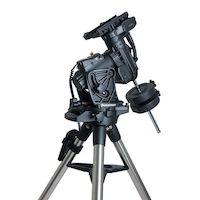
The Celestron CGX hardly weighs more than the EQ6Ri or AZ-EQ6i but has an improved visual payload capacity of 55 lbs, enough to carry the heaviest optical tubes like Celestron’s C14; heavier mounts typically suited for such a task are more or less intended for permanent observatories and hard to set up yourself. For astrophotography, it is sturdy and well-designed enough to work with most 8” and 10” optical tubes provided you of course use autoguiding and have good polar alignment. 6” apochromatic refractors are usually fine on the CGX for imaging, though the heaviest triplets may need a beefier mount. A dual Vixen/Losmandy saddle is standard, and the CGX can track past the meridian without having to be “flipped” like most equatorial mounts. However, you don’t get a polar scope and the tripod is not the beefiest, arguably serving as the weakest link in the CGX mount when it comes to tracking accuracy and stability.
$4000-$5000: Sky-Watcher CQ350 Pro
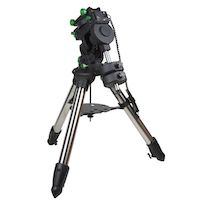
The Sky-Watcher CQ350 Pro has a 77 lb stated payload capacity, and will hold even a 14” telescope for long-exposure deep-sky imaging without a problem (as well as being, of course, rock-solid for visual astronomy). The mount head is not really any heavier than the CGX, though the massive tripod legs are quite bulky and awkward to carry around. The CQ350 features direct USB ports like the AZ-EQ6i and comes with a hand controller by default, though it’s easy to add a WiFi adapter or just control the mount directly via your PC.
Runner Ups
- $1300-$1900: iOptron GEM28
The iOptron GEM28 is an excellent mount but is harder to get used to than offerings from other brands.
The iOptron GEM28 is well-designed, with capacity and performance similar to that of the Sky-Watcher HEQ5i, but its interface and some of the mechanical aspects, such as its locks instead of normal clutches as well as quirks with power connectors and using the GoTo system make it confusing for visual astronomers and difficult to use for astrophotographers.
- $1300-$1900: iOptron CEM26
The iOptron CEM26 is a bit sturdier than the GEM28 but otherwise identical.
The iOptron CEM26 is basically the same as the GEM28 but uses a “center balanced” configuration for slightly better stability. However, it can be a little strange to set up and balance compared to the GEM28 and all of the quirks of the GEM28 persist.
- $1900-$2400: Celestron CGEM II
The Celestron CGEM II borrows many parts of the Advanced VX, including its so-so declination axis and motor drives, but isn’t much cheaper than the vastly-superior Sky-Watcher EQ6Ri.
The Celestron CGEM II is essentially a beefed-up Advanced VX with a similar visual capacity to the Sky-Watcher EQ6Ri. However, the CGEM II lacks the EQ6Ri’s belt drives, polar scope, or WiFi operability by default, and there’s no carry handle. The lower-quality drive system compared to the EQ6Ri means the CGEM II is significantly inferior for astrophotography, and the Sky-Watcher EQ6Ri occupies essentially the price range, with bonus features and improvements for both visual and astrophotography use compared to the CGEM II.
- $2400-$2800: iOptron GEM45
The iOptron GEM45 is a well-made mount but doesn’t offer much payload capacity for the money.
The iOptron GEM45 has better mechanical design and tracking performance than the GEM28 and CEM26 but essentially no improvements in weight capacity; people have put 8” Newtonian astrographs on this mount, but it struggles. Given the lack of beginner-friendliness and the ability to get a much beefier mount at this price range, it’s hard to justify the GEM45.
- $2800-$4000: iOptron CEM40EC
The iOptron CEM40C is a center-balanced version of the GEM45 and suffers from many of the same benefits and drawbacks.
The iOptron CEM40C is essentially an improved GEM45 with slightly more stability, better tracking accuracy, and bonuses like USB ports and built-in GPS. However, for visual use, there is little value in purchasing this mount due to the price and less-than-intuitive interface and setup quirks; astrophotographers with smaller telescopes benefit greatly from the high quality of the CEM40EC, but it is, of course, limited to smaller instruments.
- $4000-$5000: Celestron CGX-L
The Celestron CGX-L is not very portable but is largely similar to the CGX apart from larger shafts and other heavier-duty parts.
The Celestron CGX-L is essentially a “beefed up” CGX with various mechanical improvements, a wider counterweight shaft, a longer and stiffer dual dovetail saddle, and of course a bigger tripod. It can hold up to 75 lbs and is similar in performance and overall portability to the Sky-Watcher CQ350, though the CQ350 is less tall and quite a bit steadier.

